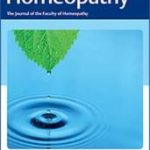Marta Marzotto, Fabio Arruda-Silva, Paolo Bellavite
Fibronectin Gene Up-regulation by Arnica montana in Human Macrophages: Validation by Real-Time Polymerase Chain Reaction Assay
Homeopathy, 2020, 109 (2), 1-6

Background and Aim – Arnica montana L. (Arnica m.) is a popular traditional medicine, used for its therapeutic properties in healing traumas, but little is known about its biological action on tissue formation and repair. This new work tested the effects of Arnica m. homeopathic dilutions on human macrophages, key cells in tissue defence and repair. Materials and Methods – Macrophages derived from the THP-1 cell line were differentiated with interleukin-4 to induce a ‘wound-healing’-like phenotype, and treated with various dilutions of Arnica m. centesimal (100 times) dilutions (2c, 3c, 5c, 9c, and 15c) or control solvent for 24 hours. RNA samples from cultured cells were analysed by real-time quantitative polymerase chain reaction in five separate experiments. Results – Arnica montana at the 2c dilution (final concentration of sesquiterpene lactones in cell culture = 10−8 mol/L) significantly stimulated the expression of three genes which code for regulatory proteins of the extracellular matrix, namely FN1 (fibronectin 1, % increase of 21.8 ± standard error of the mean 4.6), low-density lipoprotein-receptor-related protein 1 (% increase of 33.4 ± 6.1) and heparan sulphate proteoglycan 2 (% increase of 21.6 ± 9.1). Among these genes, the most quantitatively expressed was FN1. In addition, FN1, unlike other candidate genes, was upregulated in cells treated with higher dilutions/dynamisations (3c, 5c, and 15c) of Arnica m. Conclusion – The results support evidence that the extracellular matrix is a potential therapeutic target of Arnica m., with positive effects on cell adhesion and migration during tissue development and healing.






Lascia un commento
Devi essere connesso per inviare un commento.